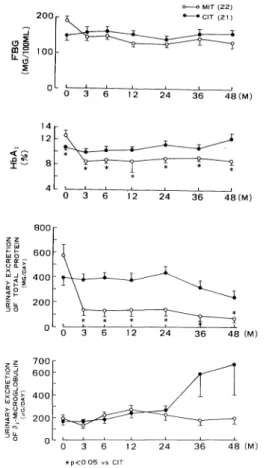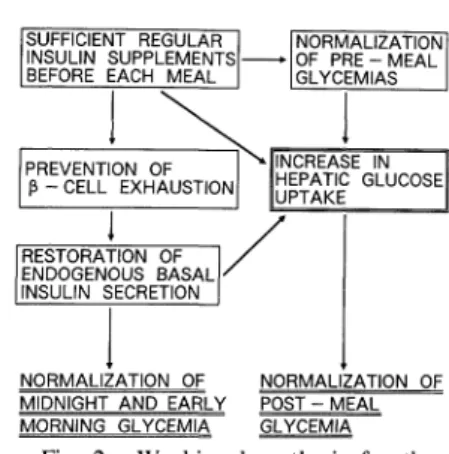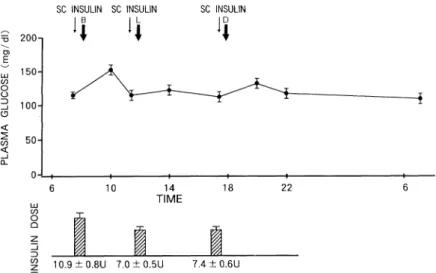Kawamoriand Kamada
tion between ARC/IRCand the presence of nephro-pathy, neuropathy and retinopathy in the 4 groups
were examined. Responses of aldosterone and its
precursors, 1 1 -desoxycorticosterone (DOC), cortico-sterone (B) and 18-hydroxy-corticocortico-sterone (1 8-OH-B) to ACTHor angiotensin II (A II) were measured in normal subjects and in the 4 groups of diabetic patients in order to examineadrenal biosynthesis in this disorder.
PRA in the diabetic patients was elevated to 2.4±2.2 from 0.8±0.6 ng/ml/h (3.2±1.7 from
1.2± 0.7 in normals) 2 h after furosemide (1 mg/kg) in an upright position. ARC was 15.8±3.3, 9.0±3.0, 13.7+2.2 and 17.4±3.0 pg/mlin diabetic groups I-IV, respectively (23.7±4.6 pg/ml in normals and 17.2 ± 3.9 pg/ml in chronic glomerulo-nephritis). On the other hand, IRC showed a high value of 323.1±87.5 pg/ml only in group IV (141.8±35.6 in normals, 149.5± 17.2 in chronic glomerulonephritis). The ARC/IRC ratio after captopril administration was, therefore, low in
group IV, but not in the other groups of diabetics. The factor most strongly correlated with the ARC/IRCratio was the creatinine clearance in the nephritis group but not in diabetic group IV. PAC was 7.5±2.6, 6.0±1.6, and 4.7±2.4 ng/100mlin groups I, II, and III and IV (N 7.7±2.2 ng/100 ml),
respectively, despite normal potassium
concentra-tions (4.3 ± 0.1 meq/1). 18-OH-B in diabetic patients with neuropathy and nephropathy (8.8 ± 3.2 ng/100 ml) was significantly lower than that in controls. No difference in B, DOC, or F (cortisol) was observed between diabetic patients and controls.
Infusions of ACTHor A II were associated with low aldosterone and 18-OH-Bresponses in group IV. B, DOCand F were increased both in diabetic patients and in controls; there was no significant
difference between diabetic patients and controls in these 3 steroids after ACTHand A II, also sug-gesting that the defect is probably at the level of the zona glomerulosa cell. HSHAwas found in 3 elderly diabetic patients with nephropathy or autonomic neuropathy of group IV and there was no signifi-cant difference in female/male ratio. A HSHA patient, in whom renal function was extremely weakened and hyperkalemia persisted, underwent an examination after 2 yr. PACwas within the normal
range (6.0-10.9 ng/100 ml) and was positively
correlated with the serum potassium level (r = 0.62, n=22). PAC rose from 10.9 to 15.8 ng/100 ml after A II and from 6.0 to 14.2 ng/100 ml after ACTH. In another HSHApatient, microscopic examination at autopsy showed severe atrophy of the zona glomerulosa and the outer layer of the zon^t fasciculata of the adrenals, hyalinization of the glomeruli, and destruction of the juxtaglomerular apparatus.
These findings suggest that, in diabetic patients, first impairment of the A II receptor occurs, and secondly corticosterone methyloxidase I and II are reduced by depletion of the renin-angiotensin system, associated with diabetic neuropathy and/or nephropathy. The development of these abnor-malities in adrenal cells may depress aldosterone biosynthesis and induce symptoms of HSHAin diabetic patients.
2, Determination of the Glycemic Threshold for the
Regression or Prevention of Diabetic Microangiopathies,
and the Insulin Injection
Regimen to Establish
Strict
Glycemic Control
in NIDDM
Ryuzo Kawamori and Takenobu Kamada
The First Department of Medicine, Osaka University Medical School, Osaka Since it is not yet clear whether strict glycemic
control can prevent the onset or progression of diabetic microangjopathies and the point of glycemicthreshold to arrest the progression of
Glycemic Threshold of Prevention of Microangiopathies o OMIT(22) 200,- t à"-à"CIT (21) ffi 10°-I 0 3 6 12 24 36 48(M) 14r 12-\ ^^J
<9 -jV-^-^^-^^
Sb 8- y-j-j-s-r-~; 4L >-1-1 ^ 1 1 1 0 3 6 12 24 36 48(M) 800-z 800-z OQ] j iip600A II I 40° - iW-»-t--'^^^ lu. 200" \ "r.
tT~^-f-1-?
° 0 3 6 12 24 36 48(M) z- 700r ^^? si 60°- /T l xg>400- /1 -à"-|p 200-f^r^4=:::^~:^ -2 2 DO QLI 1 . 1 1 1 L 0 3 6 12 24 36 48 (M) *p<0.05 vs CITFig. 1. Timecourse of fasting blood glucose, HbAl5urinary excretion of total protein per day
and /32-microglobulin in the multiple insulin injections group (MIT) and in the once daily
intermediate-acting insulin injection group (CIT). pathies remains undetermined, a randomized
pro-spective study was conducted to clarify the
relation-ship between the degree of glycemic control and the
progression of diabetic microangiopathies. In addi-tion, the method of insulin injection to non-obese
non-insulin dependent diabetic patients (NIDDM)
with secondary failure on sulfonylureas in order to strictly glycemias was investigated.
Four-year randomized prospective study
A randomized prospective study was undertaken to determine the glycemic threshold in 50 insulin-treated patients showing an early stage of diabetic microangiopathies who had been treated with once or twice daily intermediate-acting insulin injection for an average period of 6.3 yr. These were divided
randomly into 2 groups. Twenty-two patients,
main-tained on intermediate-acting insulin (once daily injection) therapy, were used as the control group (CIT). The other 28 patients were given multiple insulin injection therapy (MIT). In the latter group, all patients were treated with multiple insulin injec-tions, receiving either short-, intermediate-, or
long-acting insulin. During the experimental period, in
both groups, insulin doses were frequently adjusted
to accomplish as strict glycemic control as possible. At the time of randomization, there were no statistical differences in age, known duration of diabetes, duration of insulin therapy of insulin dose between the two groups. In CIT, for 48 months there was no significant improvement in any index of glycemic regulation for 48 months (Fig. 1). In MIT,
HbAj markedly improved from 12.5±0.4% to
8.2 ± 0.3 after 3 months, and thereafter, it was main-tained at levels around 8.5%. The insulin dose in CIT did not change throughout the period from 20.0± 1.0 U/dayto 22.3 ± 1.3 U/day at 48 months. In MIT it increased significantly, from 23.2± 1.8 U/day to 39.8±2.6 U/day at 48 months. In CIT, there was no significant change in urinary excretion
of total protein. In MIT, it decreased markedly from
the control value of 587± 112 mg/day to 130±39, 128±46, and 65 ±25 mg/day at 3, 12 and48 months later. Since systolic and diastolic blood pressure did not change during the period in either group, these improvements seemed to be affected by glycemic control. On the other hand, the urinary excretion of /32-microglobulin did not change significantly in
either group. The motor nerve conduction velocity between the elbow and the wrist showed no signifi-cant change at any point and maintained a low value in CIT. In MIT, it showed a gradual but significant improvement at every point; from 47.1 ± 1.2 m/s,
to 52.0±0.9, 52.2±0.4, and 53.9±1.1 m/sat3, 12, and 48 months later, respectively. However, the value at each point was still lower than that of 15 healthy controls. 59.0± 0.6 m/s.
The postural change in systolic blood pressure did
not change significantly in either group over the 48-month period. No significant changes in R-R intervals of electrocardiogram were observed in either group. Regarding the changes in ocular fundus photography and fluorescein angiography judged subjectively by an ophthalmologist, in the 4-yr
Kawamoriand Kamada
period there were no cases whose retinopathy improved in CIT: rather, in ll cases retinopathies worsened: In contrast, in MIT, 4 cases of improve-ment in degree of retinopathy, 2 cases with dis-appearance of microaneurysms, and 2 cases of decreased permeability of fluorescence, were observed. It was revealed that in the 4 improved cases, HbAi levels were maintained in the range
from 7.0 to 7.6% throughout the observation
period. On the other hand, even in MIT, 5 cases of deterioration of retinopathy were recognized: 1 case of dot hemorrhage, 1 case of macula edema, 1 case of microaneurysm, and 2 cases of introduction of photocoagulation. HbAi levels just prior to deterioration in these 5 patients were revealed to range from 8.0 to 8.6% (1).
From these results, it was demonstrated that the glycemic threshold is an HbAi level of lower than 8%. These results may be indicative that strict glycemic control should be initiated at an early stage or at the functionally abnormal stage of microangio-pathies.
Effectiveness ofprandial insulin supplementation in NIDDMwith secondary failure to sulfonylurea It is of no doubt that a therapeutic tool which
enhances hepatic glucose uptake, especially after meal-intake, should be utilized for strict glycemic
control in diabetics. In animal experiments, we demonstrated that portally administered insulin enhances a muchgreater hepatic uptake than that administered peripherally (2). We also showed that the hepatic glucose uptake obtained with intraportal or intrahepatic artery glucose infusion was markedly higher than that with peripheral glucose infusion,
indicating that the hepatic-general circulatory glucose gradient might be an indicator of hepatic glucose uptake (3). In addition, we recently found that the hepatic glucose uptake is greater if the peripheral glucose concentration is maintained euglycemic rather than hyperglycemic, even though the gradient was equivalent (unpublished).
From the viewpoint of insulin secretion, NIDDM is characterized by a decreased glycemic rise-related insulin secretion but with substantial amount of basal insulin is preserved (4). Recently, we have clearly demonstrated that sufficient insulin supple-ments before each meal in NIDDMnormalized
meal-related glycemic excursions, prevent beta cell exhaustion followed by restoration of endogenous
basal insulin secretion (5).
From these combined results, we have proposed the following working hypothesis in the treatment regime of non-obese NIDDMwith secondary failure on sulfonylureas (Fig. 2). This hypothesis was tested in 77 non-obese NIDDMwith secondary failure on long-term sulfonylurea treatment. The age of the patients was 58.3 ± ll.4 (mean±SD) yr. The dura-tion of diabetes averaged 18.4± 6.5 yr and duradura-tion of sulfonylurea treatment was 8.4 ± 3.5 yr. Averaged fasting blood glucose level and HbAic was 201.6±7.6 mg/dl and ll.2±0.7%, respectively. Patients were given regular insulin 30 min
pre-prandially for 3 meals. Insulin injections were initiated at doses of 10 U, 8 U, and 6 U for
breakfast, lunch and dinner, respectively. Then
according to the daily profile of blood glucose taken
every 3-4 days, insulin doses were adjusted to
obtain normal pre- and 2-h postprandial glycemias. At 4 wkafter the initiation of insulin treatment, if the pre-breakfast glycemia level was greater than 150 mg/dl, in spite of a normoglycemia after meals and before sleep, 1.25-5 mg of glibenclamide was administered at bedtime in addition to pre-meal insulin.
Perfect normalization of both meal-related and pre-breakfast glycemia levels was established in 56
cases with insulin doses of 10.9±0.8 U, for TREATMENT OF NIDDM WITH SECONDARY
FAILURE ON SULFONYLUREA
- PRANDIAL REGULAR INSULIN INJECTIONS
-SUFFICIENT REGULAR I (NORMALIZATION INSULIN SUPPLEMENTS åº OF PRE- MEAL
BEFORE EACH MEAL 1 JGLYCEMIAS
PREVENTION OF T^(INCREASE IN P-CELL EXHAUSTION [uptake
RESTORATION OF I/ ENDOGENOUS BASAL ' INSULIN SECRETION |
NORMALIZATION OF NORMALIZATION OF MIDNIGHT AND EARLY POST - MEAL MORNING GLYCEMIA GLYCEMIA
Fig. 2. Working hypothesis for the treatment of non-obese NIDDM with secondary failure on sulfonylureas.
Glycemic Threshold of Prevention of Microangiopathies
SC INSULIN SC INSULIN SC INSULIN
I B I L ID =5 200-1 å¼ å¼ å¼ ~ 150- A. § S \ i -_^*^j x 3 100- T I 50-_l Q_ o -L,6 10 , 14 , 18 , 221 16 TIME CO
-j-z 10.9±0.8U 7.0±0.5U 7.4±0.6U
Fig. 3. Mean plasma glucose profile in response to the prandial regular insulin injections in 33 non-obese NIDDMwith secondary failure on sulfonylureas. breakfast, 7.0 ±0.5 U for lunch, and 7.4±0.6 U for
dinner , respectively. Urinary C-peptide excretion rate (UCPR), during the period from ll PMto 7 AM in these patients was 1.83 ±0.ll ug/h before insulin treatment and 1.85 ±0.18 fig/h at 4 wk of treatment. However, UCPRdivided by plasma glucose area (1 1 PM-7 AM) was increased by twofold in 4 wk.
In 21 cases, even though pre- and post-meal glycemias were regulated, pre-breakfast glycemias were higher than 150 mg/dl. In 14 out of 21 cases with combined insulin and bedtime glibenclamide
therapy, the perfect glycemic excursions were established. In those 14 patients, with insulin injec-tion alone, UCPRwas 0.56 ± 0.49 //g/h. However,
after adding glibenclamide, UCPR during night
increased to 1.50±0.64 ,«g/h, showing that glibenclamide again stimulates basal insulin
secre-tion. In the other 7 patients, pre-dinner or bedtime intermediate-acting insulin injection was obligatory in addition to pre-meal regular insulin to perfectly regulate the glycemia level. With these treatments, even though insulin requirements decreased week by week, HbAic decreased rather rapidly; 9.5 ±0.6, 7.9±0.6, 7.2±0.4%, after 1, 3, and 6 months, respectively.
Thus, these studies clearly demonstrate that in NIDDM,endogenous basal insulin secretory ability is reversed dynamically and insulin sensitivity is modified in response to glycemic regulation as well.
In summary, to prevent onset or progress in
diabetic microangiopathies, it is of necessity to regulate the blood glucose excursions to the same extent as healthy subjects, even in the early stage of diabetes. Maintenance of strict glycemic regulation, in turn, facilitates ease in the treatment of diabetes with the aid of preserved insulin secretion and diminished insulin resistance.
REFERENCES
1) Kawamori R, Katsura M, Ishida S, et al. Glycemic threshold for the regression or prevention of diabetic microvascular complications : Randomizedprospective study for up to 4 years, in: Current Status of Prevention
and Treatment of Diabetic Complications, Sakamoto N, et al. Eds. Elsevier, Amsterdam, 1990, p.371. 2) Morishima T, Kubota M, Saitou Y, Kawamori R,
Shichiri M, KamadaT. Physiological significance of intraportal insulin delivery on glucose regulation, in: Advanced Models for the Therapy of Insulin Dependent
Diabetes, Brunetti P, et al. Eds. Raven Press, New
York, 1987, p.35.
3) Kubota M, Morishima T, Kawamori R, et al. The significance of arterial-portal vein glucose gradient in
the hepatic glucose uptake. Diabetes 36: 37A, 1987.
4) Kawamori R, Shichiri M, Murata T, Nomura M,
Shigeta Y, Abe H. Study of glucose tolerance and the dynamic property of insulin secretion. Analysis of
intravenous glucose tolerance test with the aid of control theory. Acta Endocrinol (Copenh) 90: 283, 1979. 5) Kawamori R, Bando K, Yamasaki Y, et al. Fasting plus
prandial insulin supplements improve insulin secretory ability12: in non-insulin680, 1989. dependent diabetics. Diabetes Care


